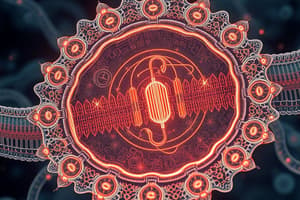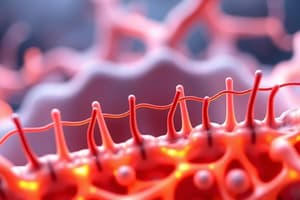Podcast
Questions and Answers
What is the primary role of phospholipids in the membrane?
What is the primary role of phospholipids in the membrane?
- To facilitate enzymatic reactions
- To form a lipid bilayer that provides structural integrity (correct)
- To transport ions across the membrane
- To act as a signal transducer
How does the distribution of cholesterol in the phospholipid bilayer affect the cell?
How does the distribution of cholesterol in the phospholipid bilayer affect the cell?
- It increases the permeability of all ions
- It aids in the formation of a rigid membrane
- It prevents the formation of integral proteins
- It regulates fluidity and permeability (correct)
What does the resting membrane potential represent?
What does the resting membrane potential represent?
- The maximum potential reached during an action potential
- The membrane potential at which there is no ion movement (correct)
- The average potential created by all ions in the cell
- The charge difference that promotes ion flow out of the cell
Which of the following statements best describes equilibrium potential?
Which of the following statements best describes equilibrium potential?
What does Bernstein’s suggestion about intracellular and extracellular potassium concentrations imply?
What does Bernstein’s suggestion about intracellular and extracellular potassium concentrations imply?
What characterizes the equilibrium potential of a cell?
What characterizes the equilibrium potential of a cell?
Which role of the Na/K pump is critical in cellular function?
Which role of the Na/K pump is critical in cellular function?
In secondary active transport, what is utilized to drive the transport of solutes?
In secondary active transport, what is utilized to drive the transport of solutes?
How does osmosis contribute to cell dynamics?
How does osmosis contribute to cell dynamics?
What is the primary function of aquaporins in the cell membrane?
What is the primary function of aquaporins in the cell membrane?
What is a consequence of deleting the gene for Aquaporin4 in mice?
What is a consequence of deleting the gene for Aquaporin4 in mice?
How does the capacitative current relate to ionic current in a membrane?
How does the capacitative current relate to ionic current in a membrane?
What distinguishes exchange (antiport) and cotransport (symport) in secondary active transport?
What distinguishes exchange (antiport) and cotransport (symport) in secondary active transport?
Flashcards
Fluid Mosaic Model
Fluid Mosaic Model
A model describing the cell membrane as a fluid structure with a phospholipid bilayer and embedded proteins. The phospholipids form a barrier to ions and molecules, while proteins provide channels for transport and communication.
Resting Membrane Potential
Resting Membrane Potential
The difference in electrical charge between the inside and outside of a cell membrane. It is determined by the distribution of charged ions across the membrane.
Membrane Capacitance
Membrane Capacitance
The ability of a membrane to store electrical charge. This property is essential for cell signaling and communication.
Equilibrium Potential
Equilibrium Potential
Signup and view all the flashcards
K+ Concentration Gradient
K+ Concentration Gradient
Signup and view all the flashcards
What is equilibrium potential?
What is equilibrium potential?
Signup and view all the flashcards
How does the Na/K pump work?
How does the Na/K pump work?
Signup and view all the flashcards
What is secondary active transport?
What is secondary active transport?
Signup and view all the flashcards
What is exchange (antiport)?
What is exchange (antiport)?
Signup and view all the flashcards
What is cotransport (symport)?
What is cotransport (symport)?
Signup and view all the flashcards
What is osmosis?
What is osmosis?
Signup and view all the flashcards
What are aquaporins?
What are aquaporins?
Signup and view all the flashcards
How can the membrane be considered as an RC circuit?
How can the membrane be considered as an RC circuit?
Signup and view all the flashcards
Study Notes
Resting Membrane Potential
- The cell membrane is a lipid bilayer with embedded proteins, forming a selectively permeable barrier.
- Phospholipids are amphiphilic, with hydrophobic tails and hydrophilic heads, spontaneously forming a bilayer in aqueous solutions.
- Integral and peripheral proteins facilitate transport and communication across the membrane.
- Cholesterol regulates membrane fluidity and permeability.
Bernstein's Model
- Intracellular potassium concentration ([K+]in) is greater than extracellular potassium concentration ([K+]out).
- Potassium permeability (PK) is significantly higher than the permeability of other ions (Pall).
- Resting membrane potential (Vm) is approximately equal to the potassium equilibrium potential (EK).
Electrochemical Equilibrium
- Equilibrium potential is the membrane potential at which the chemical and electrical driving forces for an ion are equal and opposite, resulting in no net ion movement.
Maintaining Transmembrane Ion Gradients
- The Na+/K+ pump actively transports sodium ions out of the cell and potassium ions into the cell, using ATP.
- This pump is electrogenic, contributing a small but significant voltage to the resting membrane potential.
- Secondary active transport utilizes the electrochemical gradient of one ion to drive the transport of another. This includes exchange (antiport) and cotransport (symport).
- Osmosis is the movement of water across a semi-permeable membrane from an area of high water concentration to low water concentration.
- Aquaporins are channels that facilitate water movement across membranes. Their deletion in mice affects water permeability, although other water transport can maintain normal function under normal conditions.
The Membrane as an RC Circuit
- The cell membrane acts as both a capacitor and a resistor, influencing how rapidly membrane voltage changes.
- Changes in ionic current affect capacitive current and vice-versa, influencing the overall membrane potential.
Studying That Suits You
Use AI to generate personalized quizzes and flashcards to suit your learning preferences.




